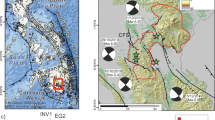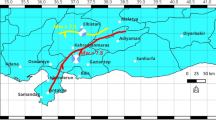Abstract
An empirical predictive relationship correlating significant duration to earthquake magnitude, site-to-source distance, and local site conditions (i.e., rock vs. stiff soil) for stable continental regions is presented herein. The correlations were developed from data derived from 620 horizontal motions for stable continental regions (e.g., central and eastern North America: CENA), consisting of 28 recorded motions and 592 scaled motions. The data set encompasses the earthquake magnitude from 4.5 to 7.6 and the distance from 0.1 to 199 km. The non-linear mixed-effects regression technique was used to fit a predictive model to the significant duration data. Similar to the trend observed from active shallow crustal region motions, significant durations predicted for stable continental region motions increased with increasing earthquake magnitude and increasing site-to-source distance. In comparing the predicted durations for CENA motions with those for motions from active shallow crustal regions (e.g., western North America: WNA), it is shown that the differences in significant durations for the two regions are relatively minor for site-to-source distances less than about 100 km. Lastly, the significant durations predicted by the proposed model are shown to be in good agreement with durations of the motions recorded during the Mineral, Virginia earthquake of August 23, 2011.
















Similar content being viewed by others
References
Abrahamson NA, Silva WJ (1996) Empirical ground motion models. Report, Brookhaven National Laboratory
Abrahamson NA, Somerville PG (1996) Effects of the hanging wall and footwall on the ground motions recorded during the Northridge earthquake. Bull Seismol Soc Am 86:S93–S99
Bommer JJ, Martinez-Pereira A (1999) The effective duration of earthquake strong motion. J Earthq Eng 3(2):127–172
Boore DM (1983) Stochastic simulation of high-frequency ground motions based on seismological models of the radiated spectra. Bull Seismol Soc Am 73(6A):1865–1894
Boore DM (1986) Short-period P- and S-wave radiation from large earthquakes: Implications for spectral scaling relations. Bull Seismol Soc Am 76(1):43–64
Boore DM, Joyner WB (1984) A note on the use of random vibration theory to predict peak amplitudes of transient signals. Bull Seismol Soc Am 74(5):2035–2039
Brune JN (1970) Tectonic stress and spectra of seismic shear waves from earthquakes. J Geophys Res 75(26):611–614
Brune JN (1971) Correction. J Geophys Res 76(20):1441–1450
Chapman MC (2013) On the rupture process of the 23 August 2011 Virginia earthquake. Bull Seismol Soc Am 103(2A):613–628
CESMD (2012) Center for engineering strong motion data. http://strongmotioncenter.org/
Hanks TC (1979) B-values and omega-gamma seismic source models—implications for tectonic stress variations along active crustal fault zones and the estimation of high-frequency strong ground motion. J Geophys Res 84(NB5):2235–2242
Hanks TC, Kanamori H (1979) A moment magnitude scale. J Geophys Res 84:2348–2350
Husid LR (1969) Características de terremotos. Análisis general. Revista del IDIEM 8, Santiago de Chile, 21–42
Kempton JJ, Stewart JP (2006) Prediction equations for significant duration of earthquake ground motions considering site and near-source effects. Earthq Spectr 22(4):985–1013
Lee J (2009) Engineering characterization of earthquake ground motions. Ph.D. dissertation, University of Michigan, Ann Arbor
McGuire RK, Becker AM, Donovan NC (1984) Spectral estimates of seismic shear waves. Bull Seismol Soc Am 74(4):1427–1440
McGuire RK, Hanks TC (1980) RMS accelerations and spectral amplitudes of strong ground motion during the san-fernando, california earthquake. Bull Seismol Soc Am 70(5):1907–1919
McGuire RK, Silva WJ, Costantino CJ (2001) Technical basis for revision of regulatory guidance on design ground motions: hazard- and risk-consistent ground motion spectra guidelines. US Nuclear Regulatory Commission, Washington, DC
Pinheiro JC, Bates DM (2000) Mixed-effects models in S and S-PLUS. Springer, New York
Program-R (version 2.5.0) A language and environment for statistical computing and graphics. http://www.r-project.org/
Schneider JF, Silva WJ, Stark C (1993) Ground motion model for the 1989 M 6.9 Loma Prieta earthquake including effects of source, path, and site. Earthq Spectra 9(2):251–287
Silva W (1993) Factors controlling strong ground motion and their associated uncertainties. In Dynamic analysis and design considerations for high-level nuclear waste repositories. San Francisco, CA, USA, pp 132–161
Silva WJ, Lee K (1987) WES RASCAL code for synthesizing earthquake ground motions: state-of-the-art for assessing earthquake hazards in the United States. Report 24, US Army Engineering Waterways Experiment Station Vicksburg, MS
Somerville PG, Smith NF, Graves RW, Abrahamson NA (1997) Modification of empirical strong ground motion attenuation relations to include the amplitude and duration effects of rupture directivity. Seismol Res Lett 68(1):199–222
Trifunac MD, Brady AG (1975) Study on duration of strong earthquake ground motion. Bull Seismol Soc Am 65(3):581–626
U.S. Nuclear Regulatory Commission (2007) A performance-based approach to define the site-specific earthquake ground motion. Regulatory Guide 1.208, March
Acknowledgments
This material is based upon work supported in part by the National Science Foundation under Grant Nos. CMMI 0962952 and CMMI 1030564. Also, the second author was partially supported by funds from a grant from the U.S. National Science Foundation (NSF) as part of the Geotechnical Extreme Events Reconnaissance (GEER) Association activity through CMMI-00323914. All support is gratefully acknowledged. However, any opinions, findings, and conclusions or recommendations expressed in this material are those of the authors and do not necessarily reflect the views of the National Science Foundation. The authors sincerely thank two anonymous reviewers whose comments resulted in an improved paper.
Author information
Authors and Affiliations
Corresponding author
Appendix: Scaling procedure for CENA motions
Appendix: Scaling procedure for CENA motions
The scaling procedure used by McGuire et al. (2001) consists of the following computation processes: (1) determination of response spectral transfer function, (2) computation of response spectrum for a given ground motion, (3) determination of target response spectrum, and (4) spectral matching of the time history. A response spectral transfer function was obtained by first using the single-corner frequency point source model (Brune 1970, 1971) to compute smoothed Fourier amplitude spectra (FAS) for both the CENA and WNA. The values of the point source model parameters used are listed in Table 4, where \(\kappa \) is a parameter that represents damping in the shallow crust directly below the site; \(\Delta \sigma \) represents the stress drop at the source;\(Q_{0}\) and \(n\) are regional dependent parameters for the frequency dependent quality factor, \(Q(f)\); \(\rho _{0}\) is crustal density in the source region; and \(\beta _{0}\) is shear wave velocity of the crust at the source. Next, random vibration theory (RVT) was used to generate response spectra from the FAS (e.g., Boore 1983; Boore and Joyner 1984; Silva and Lee 1987). The ratio of these two response spectra is the spectral transfer function. The response spectral transfer functions were generated for each site condition; horizontal/vertical component; earthquake magnitudes of 5.5, 6.5, and 7.5 (i.e., center value of magnitude bins); and distances of 1, 5, 30, 75, and 130 km. A total 60 different transfer functions were therefore developed. Example transfer functions for M6.5 cases are shown in Fig. 17. The response spectrum (5 % damping) of a WNA “seed” acceleration time history is then computed. Next, the CENA target response spectrum is obtained by multiplying the “seed” motion’s response spectrum by the appropriate response spectral transfer function. Lastly, the “seed” acceleration time history is scaled to match the target CENA response spectrum (Silva and Lee 1987). In the spectral matching process, a sample time interval \(\Delta \)t of 0.005 sec (the corresponding Nyquist frequency is 100 Hz) was used to avoid aliasing effects in the frequency range of interest.
Response spectral transfer functions for M6.5, rock and soil sites, horizontal and vertical components, and each distance cases (from McGuire et al. 2001)
Rights and permissions
About this article
Cite this article
Lee, J., Green, R.A. An empirical significant duration relationship for stable continental regions. Bull Earthquake Eng 12, 217–235 (2014). https://doi.org/10.1007/s10518-013-9570-0
Received:
Accepted:
Published:
Issue Date:
DOI: https://doi.org/10.1007/s10518-013-9570-0





